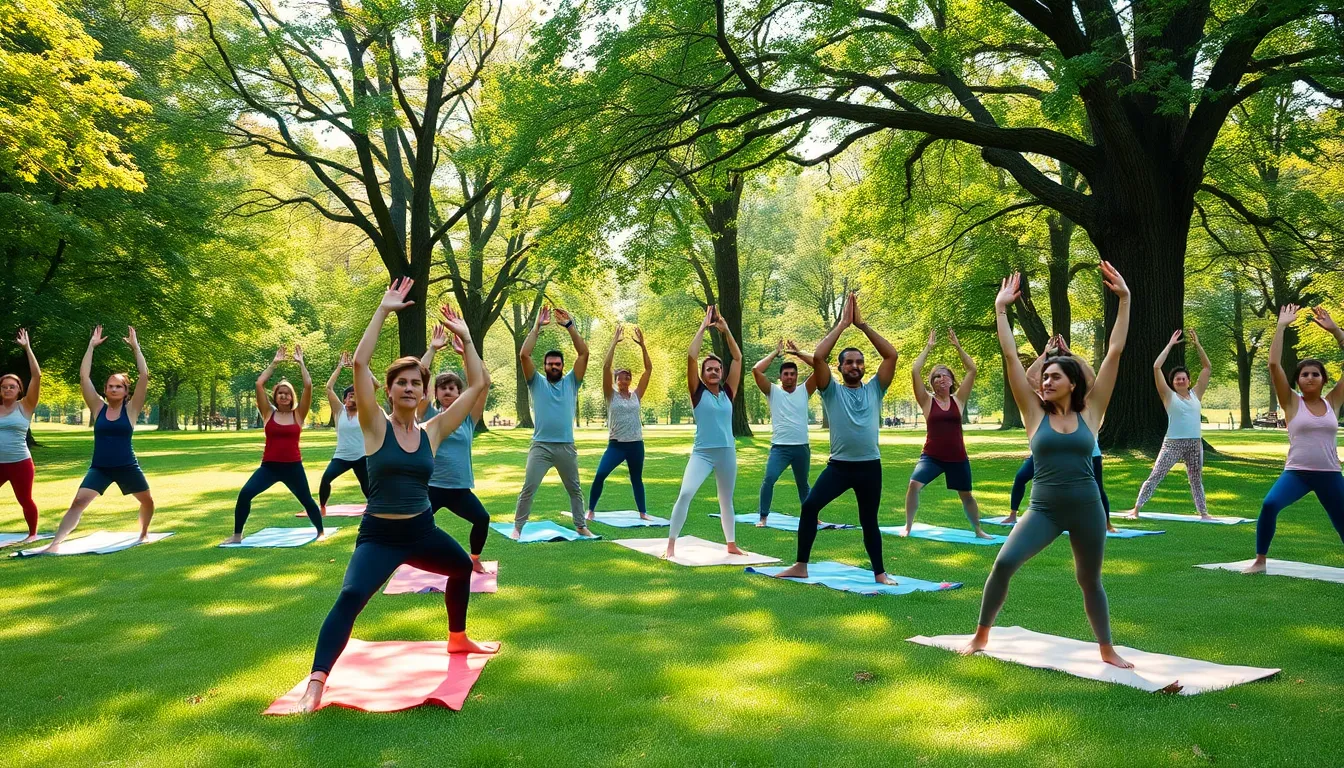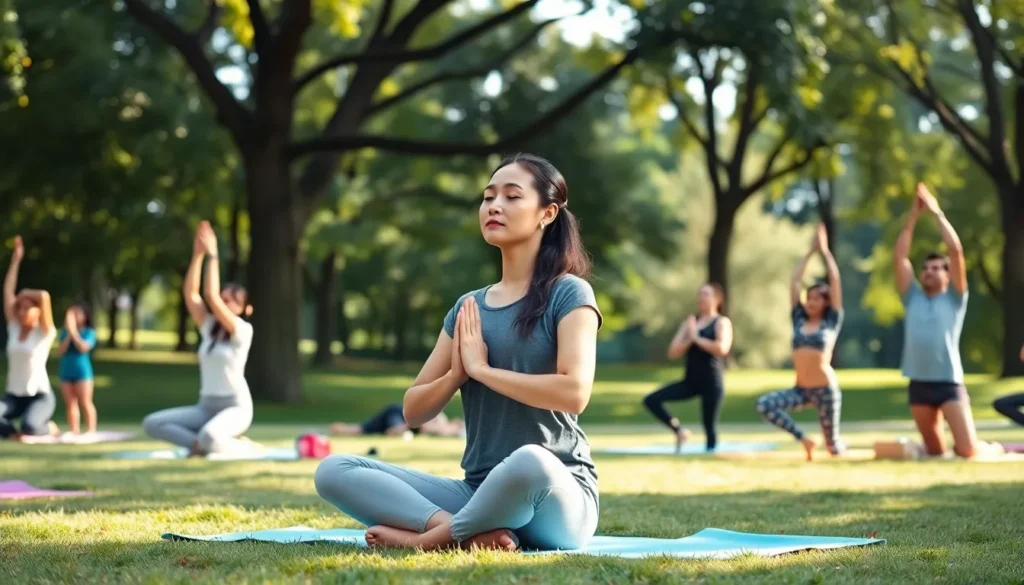In a world buzzing with distractions, mindfulness yoga offers a refreshing escape. Imagine stretching into a downward dog while your mind drifts away from that never-ending to-do list. It’s like a mini-vacation for your brain, minus the sunscreen and awkward tan lines.
This unique blend of yoga and mindfulness not only enhances flexibility but also helps cultivate a sense of inner peace. Whether you’re a seasoned yogi or just trying to touch your toes without grunting, mindfulness yoga invites everyone to find their zen. So, roll out that mat and prepare to laugh, breathe, and maybe even discover a new side of yourself—one that’s a little less stressed and a lot more balanced.
Mindfulness Yoga
Mindfulness yoga merges traditional yoga practices with mindfulness techniques. This combination enhances awareness of the body and breath during each pose. Practitioners learn to focus on the present moment, which helps reduce mental distractions.
Mindfulness yoga includes various styles such as Hatha and Vinyasa. Each style emphasizes breath control, body alignment, and meditation. These practices encourage flexibility and promote relaxation. Through sustained engagement, individuals can experience improved physical strength and mental clarity.
Regular mindfulness yoga sessions lead to numerous benefits. One significant benefit is stress reduction. Research indicates that mindfulness practices can lower cortisol levels, which are often linked to stress. Another advantage is enhanced emotional balance. Individuals gain tools to manage anxiety and improve overall well-being through consistent practice.
Beginners often find mindfulness yoga accessible. Classes cater to all experience levels, focusing on slow, intentional movements. Instructors emphasize listening to the body and respecting individual limits, creating a safe environment for all.
Mindfulness yoga also supports mental health. Studies show that mindfulness practices contribute to lower rates of anxiety and depression. With continued practice, individuals discover a deeper connection to their thoughts and emotions. This awareness fosters self-acceptance and promotes a more positive outlook on life.
Mindfulness yoga offers a holistic approach to wellness. Engaging in this practice encourages inner peace and fosters a balanced existence. As participants deepen their practice, they unlock new levels of self-awareness and personal growth.
Benefits of Mindfulness Yoga

Practicing mindfulness yoga offers significant advantages for both the body and mind. Emphasizing the mind-body connection enhances overall well-being.
Physical Benefits
Mindfulness yoga improves flexibility and strength. Participants often find increased physical resilience through poses that engage different muscle groups. Managing breath support strengthens body alignment, promoting better posture. Regular practice can also lead to enhanced balance, which reduces injury risk. Sessions designed for all levels accommodate individual limitations, making yoga accessible to everyone. Research shows that physical activity boosts cardiovascular health and aids in weight management, supporting a holistic approach to fitness.
Mental Benefits
Mindfulness yoga nurtures a calm mind and emotional balance. Reducing stress is a primary benefit, as studies indicate that mindfulness practices lower cortisol levels. Practitioners experience enhanced focus, which improves productivity throughout daily tasks. Developing an awareness of thoughts and emotions fosters self-acceptance, contributing to lower anxiety and depression rates. Regular engagement leads to a more positive outlook on life. Many find that centering their thoughts in the present moment enhances coping mechanisms in challenging situations.
Key Principles of Mindfulness Yoga
Mindfulness yoga encompasses specific principles guiding practitioners towards greater awareness and inner peace. Emphasis on a holistic connection between mind and body marks this practice.
Mindfulness Practices
Being present is central to mindfulness yoga. Practitioners observe their thoughts without judgment, allowing for deeper self-awareness. Focusing on the breath fosters calmness and clarity amidst distractions. Regular practice cultivates emotional resilience, supporting individuals through stressful experiences. Mindfulness meditation complements yoga sessions, enhancing overall effectiveness by promoting relaxation and insight.
Yoga Techniques
Incorporating various yoga techniques elevates the mindfulness experience. Hatha yoga, known for its focus on asanas and breath, builds strength and flexibility. Vinyasa flows connect movements to breath, creating a meditative rhythm. Iyengar yoga emphasizes precise alignment, offering stability and safety during practice. Additionally, restorative yoga encourages deep relaxation, enabling the body to heal and rejuvenate. Practitioners can explore different styles, discovering what resonates with their needs and enhancing their mindfulness journey.
How to Get Started with Mindfulness Yoga
Getting started with mindfulness yoga involves selecting the right class and gathering essential equipment. This ensures a comfortable and effective practice.
Finding the Right Class
Begin by searching for classes that focus on mindfulness principles. Options include Hatha, Vinyasa, and restorative yoga, each offering different benefits. Some studios cater specifically to beginners, making the transition easier. Participating in a trial class helps determine which style resonates best. Instructors should emphasize slow, intentional movements with mindfulness techniques. Local community centers or online platforms often provide accessible options for varied schedules. Many practitioners find group settings motivate them to stay committed to their practice.
Essential Equipment
Gathering essential equipment enhances the mindfulness yoga experience. A quality yoga mat provides the necessary grip and cushioning for comfort. Blocks can assist in achieving proper alignment. Straps are useful for deepening stretches without straining the body. Comfortable clothing facilitates movement and breathability. Consider adding a bolster for support during restorative poses. Finally, a meditation cushion encourages better posture during seated practices. Each piece of equipment serves to support the alignment of body and mind.
Challenges and Misconceptions
Misconceptions often surround mindfulness yoga, leading to confusion about its purpose and effectiveness. It’s frequently viewed as a simplistic practice focused solely on relaxation. Many believe that mindfulness yoga lacks physical challenge; however, various styles effectively enhance strength and flexibility.
Some practitioners worry about their abilities, thinking they need to achieve perfect poses to benefit from the practice. Flexibility and strength develop over time, so focusing on progress rather than perfection fosters a supportive environment for growth.
The notion that mindfulness yoga is only for those who are already fit or flexible deters some beginners from participating. Classes cater to all experience levels, emphasizing slow, intentional movements and respect for individual limits. Inclusivity encourages participation and nurtures a sense of community.
Fear of judgment often influences individuals, leading them to avoid mindfulness yoga altogether. Creating a non-judgmental atmosphere in classes promotes acceptance and encourages personal exploration. Practitioners can focus on their journeys without comparing themselves to others.
Another challenge involves the misconception that mindfulness yoga requires lengthy commitment or extensive time investment. Short, focused sessions can yield significant benefits, making the practice accessible for busy lifestyles. Consistent practice, regardless of duration, enhances mental clarity and emotional balance.
Many people wonder about the effectiveness of mindfulness techniques in yoga. Research supports the positive impact of mindfulness practices on stress reduction and overall well-being. Embracing mindfulness yoga can transform one’s approach to daily challenges, enhancing resilience and encouraging a balanced lifestyle.
Conclusion
Mindfulness yoga offers a transformative journey toward holistic well-being. By blending physical movement with mental focus it cultivates a deeper connection between body and mind. This practice not only enhances flexibility and strength but also supports emotional balance and resilience.
For those seeking a path to reduce stress and improve mental clarity mindfulness yoga provides an accessible and inclusive option. With a variety of styles available practitioners can find the perfect fit for their individual needs.
Embracing mindfulness yoga can lead to a more positive outlook on life fostering self-acceptance and personal growth. As individuals commit to this practice they’ll discover the profound benefits that come from being present in each moment.

